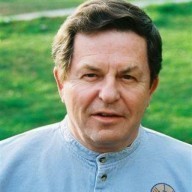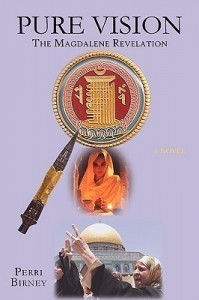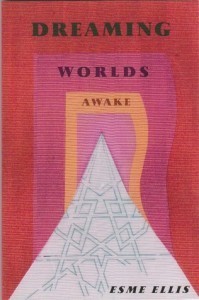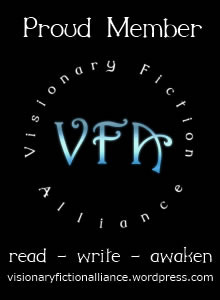Victor E. Smith's Blog, page 5
September 5, 2013
Special Offer on Works of Monty Joynes, Pioneer Visionary Fiction Author
Just today, Sept 4, 2013, I received the following email from Monty Jones, author of the classic Visionary Fiction Booker series (Naked into the Night, Lost in Las Vegas, Dead Water Rights), and I want to share his generous offer on what may be the final edition of his printed works with Visionary Fiction fans:

Author Monty Joynes
Hi Vic,
Pat [Monty's wife] and I have worked for the last month to get my pioneer visionary novels back in circulation after the publisher delisted them after 16 years. Pat was also able to put up the 5th novel in the Booker Series, Psalm Maker, which had not been published. These are now Kindle books, but we are planning to put them up on additional platforms.
I hope that you will help us spread the word that these books are now available. Note the good reviews that these books got on publication.
We purchased 100 sets of the four Booker Series novels that we are offering at a 50% discount. When these trade paperback books are sold, that’s the end of them unless we can attract a new print publisher. I will inscribe each book as directed by the buyer. Sorry, I cannot offer single books.
We have another book coming out this year that qualifies as “visionary non-fiction”. Confessions of a Channeler is the title.
For further info and to order, go to http://writingasaprofession.wordpress.com/2013/09/01/visionary-fiction-the-booker-series-restoration/
Also watch for my forthcoming interview with Monty Joynes here on the Visionary Fiction Alliance site.
********
 Click to subscribe to this site’s RSS Feed.
Click to subscribe to this site’s RSS Feed.Click this link to order a copy of The Anathemas, a Novel about Reincarnation and Restitution.Copyright 2013 by Victor E. Smith. All rights reserved.
Share your thoughts on this post. Put in your comment in the space below. Thank you.
September 1, 2013
Serpente Gigante by J. Allan Danelek

Serpente Gigante by J. Allan Danelek
This Monster Thriller Packs a Bite
Horror is not my genre of choice, but I do dip into unfamiliar waters occasionally, if only to make sure I’m not missing something. As a fan of several non-fiction titles on reincarnation and other paranormal phenomena by J. Allan Danelek, I thought I’d give his latest fiction work, Serpente Gigante, a wary try, even though the antagonist, as described on the back cover, “a genetically engineered anaconda of extraordinary size with a ravenous appetite for the things that live on and beneath the river—especially human beings,” did nothing to coax my interest.
But once the story got going there was something, perhaps its realistic telling, which wakened the sense of suspended judgment and wonder that I once had about such tales as a boy. For the first time in decades, I remembered how I devoured every Tarzan and Bomba the Jungle Boy book I could find. Through them I toured Africa and South America for endless imaginative adventures even though my youth was spent all within a hundred miles of my birthplace. I can credit them and other such adventure stories, easily digested by the juvenile mind, for a lifelong curiosity about the planet’s geography, diverse cultures, and customs, which blossomed as an adult life into a love of travel to places off the beaten tourist path. As I continued the book, I was delighted that Serpente Gigante provided a similar vicarious experiencing of the Amazon River region, which I have not yet visited, and its possibilities.
The “science” of the book, despite the preposterous critter at its center, is credible. No obvious use of the deus ex machina that makes the discerning reader jump out of the story with a disgusted “No way.” Rather than in the Introduction, I would have put the information that his protagonists would eventually marry and form a snake-hunting partnership, something that happens in a later volume of the series, Paul and Sarah Manhart Cryptozoological Adventures, in an Afterword or not at all. Having access to that tidbit in advance took the edge off the scenes where Sarah was in mortal distress or the success of their romance seemed unlikely.
In total, a captivating and curious yarn by Mr. Danelek, already quite the established expert in Fortean phenomena. Caution: some of the scenes presented in the book may cause macabre nightmares in the susceptible.
August 28, 2013
Saurimonde by Scarlett Amaris and Melissa St. Hilaire

Saurimonde by Melissa St. Hilaire and Scarlett Amaris
With Saurimonde being my first taste of the dark fantasy/horror/paranormal romance genre—I couldn’t resist the taunting dare in the blurb—I cannot compare it to similar works. So this review is not that of an “expert” but of a casual passerby, lured by other common causes with one of the authors, Scarlett Amaris, and an abiding curiosity about books that fall, however loosely, into the wide spectrum of literature that might be classified as “visionary fiction.” The stylized Playboy cover with its promise of titillation, I admit, also helped me, an older male with otherwise less flamboyant reading habits, open the door and walk into the authors’ foreboding den of dreamy fairytale, explicit sexuality, and shudder-inducing evil perpetrated not only by Gilles, an over-the-top caricature of the domineering and lecherous husband, but also by the beautiful and sensual Saurimonde, of whom we’d least expect such.
First observation: it’s a page turner. While I often struggle through the last hour of the day allotted to reading, evenings with Saurimonde always shot right past my bedtime. Perhaps it was a combination of the story’s surface simplicity, the breezy language (the use of modern slang in a medieval setting did take some adjustment), and lavish imagination that propelled me into that magical zone beyond the ticking clock.
But beyond the entertainment and stimulation provided by the strong dose of sex and mayhem, there was a subtle sense of something a lot deeper. However, unlike some books in which the intended message is made annoyingly explicit—You, dear reader, are likely too dumb to get it right, so I’m going to spell it out for you—Saurimonde just left me wondering. My imagination was awakened to fantastic possibilities on several levels, not unlike the effect of the timeless classical fairy tale, the prototype for all visionary fiction. Now that’s pretty high magic for any book to achieve. Highly recommended—if you dare.
********
 Click to subscribe to this site’s RSS Feed.
Click to subscribe to this site’s RSS Feed.Click this link to order a copy of The Anathemas, a Novel about Reincarnation and Restitution.Copyright 2013 by Victor E. Smith. All rights reserved.
Share your thoughts on this post. Put in your comment in the space below. Thank you.
August 2, 2013
PURE VISION by Perri Birney: Da Vinci Code Knock-off or Pristine Vision?

Pure Vision: The Magdalene Revelation by Perri Birney
The yellow lights came on, flashing furiously, at the blurb describing Perri Birney’s, PURE VISION, The Magdalene Revelation: stolen ancient artifact…dangerous journey…legendary treasures…clandestine pseudo-Masonic group. Not another one, I protested, all 586 pages of it. I admit to having been addicted to such yarns in the pre-Da Vinci Code era, lapping up everything of the type, fiction and non-fiction from Holy Blood, Holy Grail to William Valtos’s La Magdalena, so overindulging that by the time Dan Brown’s tour de force came out, it was old hat. Now, post-DVC, any book paired with The Da Vinci Code or touting a similar storyline makes me buggy; my reading list is plenty long.
However, I am currently on a mission to taste all flavors of works labeled visionary, metaphysical, spiritual or any combination of thereof, aiming to sort out when and how these related genres are the same, similar, or different. And since I first encountered Birney through the Visionary Fiction Alliance, I felt I owed what her Amazon Editorial Review touted as an “epic novel with feminine echoes of The Da Vinci Code” a fair hearing. If nothing else, it might help in judging whether any of the ubiquitous DVC knock-offs of the breathless, globe-trotting, save-the-world variety might qualify as worthy Visionary Fiction.
A couple of disclosures here. First, as someone who knows the heroic task involved in producing a coherent first novel, especially such a lengthy one, I consider it a mortal sin to cast aspersions on the effort; worst case scenario, I’ll pass if I can’t say something positive. Second, I am a man critiquing a book whose primary audience is women; but I assume, just by being one of the rarer males in the visionary field, that women writers won’t object to having men read and appreciate their work (as long as we pay).
Don’t take me wrong. Pure Vision is no cronish feminist diatribe—several of its primary characters are men of intelligence and good intent—although it heaps ample, and deserved, disdain on the patriarchal paradigm that makes our world the violent, greedy and unbalanced place it so often is. Nor is the book all spiritual sentiment; Birney writes some mean action scenes with the requisite pounding hearts and footsteps, guns and bombings, blood and even a gory beheading; sufficient suspense and violence for those who crave that sort of thing. Also, featured along with mystical material from many of the world’s spiritual traditions are modern scientific threads (free energy, earth geometry, quantum physics) that ground its utopianism in practical possibility should we care to share rather than hoard the planet’s resources.
While reading Pure Vision, I thought of author Katherine Neville, whom I’d read with satisfaction pre-DVC. Unable to recall her titles, I checked on Amazon, only to take umbrage that one of my favorites, The Magic Circle, was thus described by Publisher’s Weekly: “Neville’s reach exceeds her grasp by a long shot in her chaotic third novel (after The Eight and A Calculated Risk), a bewildering attempt to blend historical fiction, New Age adventure and modern techno-thriller.” Was my taste or memory that bad? And yet the book, I noticed, has 195 four and five-star customer reviews against 89 one and two-stars. The Magic Circle did not get a Pulitzer, but Neville attracted plenty of attention writing in this genre. And that well before Dan Brown made it the “in” thing.
Beyond all the literary slicing and dicing, I read PURE VISION: The Magdalene Revelation with relish. It kept me turning the pages, meaning it was either teaching me something new or repeating things I needed to hear again. Most tellingly, all the way through I sensed the book’s beating heart: the resolute vision of peace, framed and sustained by its heroine, the Magdalene, and her army of women, marching from the four corners of the earth to create the new Jerusalem. Their effort is necessarily sprawling, messy and spontaneous, and often enough the book’s sequencing and loose ends reflect this dishevelment. Likely disconcerting to those habituated to the neat rationalism of categorization and division that has reigned supreme for millennia now—but how’s that worked out all around? Perhaps it’s time, to listen to the women, to allow the heart to pump blood to the bloated head. Pure Vision presents no detailed plan for world peace, but it gives the reader the feeling that it really is quite possible. That’s visionary.
Order PURE VISION, The Magdalene Revelation on Amazon.com.
 Click to subscribe to this site’s RSS Feed.
Click to subscribe to this site’s RSS Feed.
Click this link to order a copy of The Anathemas, a Novel about Reincarnation and Restitution.
Copyright 2013 by Victor E. Smith. All rights reserved.
Share your thoughts on this post. Put in your comment in the space below. Thank you.
July 19, 2013
Dreaming Worlds Awake by Esme Ellis: A Potpourri, in More Ways than One
 Esme Ellis’s Dreaming Worlds Awake is a “potpourri” in several of the word’s meanings. As announced in the subtitle, “Stories, Synchronicities, Dreams and Correspondence, with a scatter of poems,” it is a miscellany of literary extracts exploring: “New consciousness, New energy, New writing.” The book is true to its description.
Esme Ellis’s Dreaming Worlds Awake is a “potpourri” in several of the word’s meanings. As announced in the subtitle, “Stories, Synchronicities, Dreams and Correspondence, with a scatter of poems,” it is a miscellany of literary extracts exploring: “New consciousness, New energy, New writing.” The book is true to its description.
But there were times while reading that my (patently masculine) mind went, “Hunh, why is this in here?” or “Are these actual quotes from a disembodied entity named Kuthumi or something the author made up?” In which case the book struck me as a potpourri in the sense of “any mixture, especially of unrelated objects, subjects, etc.” Perhaps intentionally, some of the tidbits tossed out left me hungry. I bless the Internet when it came to the sections on Jacob Epstein’s work—my education in sculpture is shamefully limited. It took the images there (e.g., The Rock Drill) to add substance to the author’s enthusiasm over art objects I’d never seen. But I don’t complain: I like a book that makes me look further to learn something new. What a gift to have come to know Jacob and the Angel and its powerful message, as Esme explained it: “Aspects of the human being which are normally, in some parts of the Christian world at any rate, seen as separate, the Divine and the born-in-sin, fallible human, here they’re in a process of attaining a Wholeness which embraces both Light and Dark.” I experienced, perhaps for the first time, a stone statue whirling with dynamic energy.
“Potpourri” has a third meaning that perhaps best, if metaphorically, applies to Esme’s delicately woven web: “a mixture of dried petals of roses or other flowers with spices, kept in a jar for their fragrance.” It was not a book I could toss aside upon completion, facilely assigning it five stars or one. Its impression lingers, evoking “I wonder if…” at unexpected moments. The bloody line between reality and fantasy, between the objective and subjective, between non-fiction and fiction, which I’m supposed to be able to count on when all else fails, has again been blurred and I’m left in that excruciating but oh-so-present “space between” where it is all up to me to decide, arbitrary as it may seem, what is and what isn’t.
Highly recommended, especially to those curious to get inside the writer’s mind and see the visionary genius at work.
********
 Click to subscribe to this site’s RSS Feed.
Click to subscribe to this site’s RSS Feed.Click this link to order a copy of The Anathemas, a Novel about Reincarnation and Restitution.
Copyright 2013 by Victor E. Smith. All rights reserved.
Share your thoughts on this post. Put in your comment in the space below. Thank you.
July 5, 2013
Paranormal Series #4 PSYCHOKINESIS—Remote Control over Matter

Reflecting Pool at Sunset, Washington DC
The efficacy of the remote control is a given in the 21st Century. We use one for everything from starting our cars without leaving the house to sending nuclear missiles against targets on the other side of the planet. Its role in engendering the current crop of gigantic couch potatoes is debatable, but that’s a discussion for another day.
Old-fashioned remotes, many still around, required at least a finger muscle to flip the switch, but they are rapidly giving way to more sensitive gadgets that take only a tap, wave, or voice command to activate. And rumor has it that advanced electronics labs about to produce mind-activated remotes, which will allow us to control the world without ruffling a single physical particle. Modern science is drawing nigh to realizing what was once a mystical myth: mind over matter.
Parapsychology has long had a term for the power to move or transform physical objects solely through a mental process: psychokinesis (psycho=mind, kinesis=motion), abbreviated PK. Related to and often taken as synonymous, although there is a subtle difference (see Psychokinesis in Wikipedia, if you must), is the term telekinesis (tele=distance as in telephone) or TK. Psychokinesis will do for our non-technical discussion here.
When it was first observed by credentialed people and thus suspected to be more than a primitive hallucination, (telekinesis was coined way back in 1890 and psychokinesis in 1914), psychokinesis attracted considerable scientific attention and experimentation that predictably waned when the physical motive force behind it could not be isolated with traditional laboratory tools and experiments. Since reported events like levitation of objects or spoon-bending violated the known laws of physics (gravity and thermodynamics, in these cases) and no adequate physical explanation could be found, it followed that the observed event was either achieved by trickery (the sleight-of-hand of carnival magicians) or did not really happen at all (an illusion).
Tellingly though, experimentation with psychokinesis did continue under government auspices. Witness the strong Soviet interest as related in Sheila Ostrander’s 1970 classic, Psychic Discoveries Behind the Iron Curtain. US efforts were centered in a CIA-sponsored project at Stanford Research Institute, which produced such psychic stars as Ingo Swann and Hal Puthoff and material for Jon Ronson’s book and the movie, The Men Who Stare at Goats. Psychokinesis evidently had some military and intelligence potential; nevertheless, leaks about such projects were dismissed with a hurried “Yea we checked it out, but nothing there,” leaving us to wonder what is in all those Top Secret files that are supposedly about nothing.
Academic scientists traditionally demand a higher standard of evidence for PK and other paranormal powers, following the rule of Marcello Truzzi (professor of sociology 1935-2003, nicknamed “the skeptic’s skeptic”): Extraordinary claims require extraordinary proof. Since PK-like results can be produced by trickery, special effects, poor experimental design, or even chance, the burden of proof on the possibly genuine instance is so high as to be impossible. Like the many climate-change deniers who won’t believe that the earth is warming until it is too hot to live here, paranormal skeptics won’t believe their eyes until PK is available to anyone on demand without even a blink of the mind.
Let me point out an error in the method of evaluating here: physical laws do not apply to the non-physical realm and thus cannot be used to measure it. A simple example: if I share a physical pie with three other people, my share of pie is depleted by three-quarters. If I share a piece of non-physical information—how to bake a pie, for instance—with several others, my whole ability to bake a pie remains intact and is likely increased, as those others will improve on my method and provide feedback. Even simple arithmetic goes out the window in that “other” realm. Evidence for PK and other paranormal phenomena has to be evaluated in the realm in which they exist, and that, by definition, is the non-material universe.
Just as one cannot learn without concentration, one cannot achieve consistent paranormal results without meeting certain requirements. In BEYOND THE OCCULT, author Colin Wilson notes: “Since the use of such powers [like PK] involves relaxation it would seem to follow that the first step towards learning to use them would be to learn to relax.” Any wonder that paranormal ability is so rare in a society where relaxation is defined as sitting in front of a mind-numbing TV with a mind-numbing cocktail in hand?
Once a person can truly relax, as through basic meditation that quiets the mind, there is a further condition according to Wilson: “What seems clear is that these powers somehow involve the positive use of imagination.” He gives an example of having no luck moving an object with thought until he made a mental image of the object moving on its own. That, according to him, did the trick: the physical object began to rotate without physical intervention.
There’s quite the cosmic joke buried in this: one curious result observed in PK lab experiments is not that believers often get results above average, which does happen, but that skeptics often get lower than average results. The skeptic is visualizing it not happening, and so it doesn’t happen, thus proving that seemingly universal rule: you get what you visualize. You may have to play in the mind-over-matter sandbox for a bit before you enjoy the joke in this.
So no “how to move objects with your mind in one easy lesson” here, but some ideas, I hope, that might empower that quantum leap we all dream to take to that next level where the paranormal becomes the new normal.
NEXT TIME IN THE PARANORMAL SERIES: REMOTE VIEWING
********
 Click to subscribe to this site’s RSS Feed.
Click to subscribe to this site’s RSS Feed.Click this link to order a copy of The Anathemas, a Novel about Reincarnation and Restitution.Copyright 2013 by Victor E. Smith. All rights reserved.
Share your thoughts on this post. Put in your comment in the space below. Thank you.
May 3, 2013
The Visionary Fiction Alliance
 I recently had the good fortune to come across the website of a group of like-minded writers who had formed the Visionary Fiction Alliance. Of course, I jumped in enthusiastically and joined. My effort to help make the “visionary” genre better known started ten years ago, after several grueling rounds with agents over an earlier version of my novel, The Anathemas (eventually published by Outskirts Press in 2010). My novel, like many of its type, a hybrid (literary/historical/paranormal/spiritual) that did not fit easily into the established genres, posed quite a problem to agents and publishers I discovered. And so the attempt to create an appropriate “slot” to accommodate the marketing problem began.
I recently had the good fortune to come across the website of a group of like-minded writers who had formed the Visionary Fiction Alliance. Of course, I jumped in enthusiastically and joined. My effort to help make the “visionary” genre better known started ten years ago, after several grueling rounds with agents over an earlier version of my novel, The Anathemas (eventually published by Outskirts Press in 2010). My novel, like many of its type, a hybrid (literary/historical/paranormal/spiritual) that did not fit easily into the established genres, posed quite a problem to agents and publishers I discovered. And so the attempt to create an appropriate “slot” to accommodate the marketing problem began.
Early research led to Michael Gurian, better known as a social philosopher and author on child development, and his fledgling website visionaryfiction.org. Michael got my attention when he said: “Visionary fiction is fiction in which the expansion of the human mind drives the plot.” I intended to fall in step with his effort, only to discover that his professional work had crowded out his experimentation with VF. I made several further efforts to keep the “visionary” torch burning: through a now-defunct Yahoo discussion group, in a What is Visionary Literature? page and blog entries on my website, and by keeping in touch with visionary authors and readers I’d encountered over the years. I managed to toss some snowballs, but none set off the anticipated avalanche that the “visionary” genre seemed to deserves. If, as VFA author Jodine Turner says, “Visionary Fiction speaks the language of the soul. It offers a vision of humanity as we dream it could be,” then VF should be included on everyone’s reading list.
Perhaps somewhat the grizzled veteran of battles seemingly lost or the fool rushing in where only angels should be allowed to tread (apologies to Alexander Pope for the emendation), I join the Visionary Fiction Alliance optimistic over the vision of what the visionary genre can mature to be. There is still much to be done and it is going to take a team, but kudos to the VFA’s pioneers for the great progress so far, and I encourage all fellow visionary authors to check out the enlightening material and join our conversations on the Visionary Fiction Alliance’s website.
********
 Click to subscribe to this site’s RSS Feed.
Click to subscribe to this site’s RSS Feed.Click this link to order a copy of The Anathemas, a Novel about Reincarnation and Restitution.Copyright 2013 by Victor E. Smith. All rights reserved.
Share your thoughts on this post. Put in your comment in the space below. Thank you.
April 3, 2013
Paranormal Series #3: PSYCHOMETRY: MEASURING THE SOUL

The Cathar castle Queribus in France
Psychometry, the first specific form of paranormal or extra-sensory perception we will examine is defined as “the ability or art of divining information about people or events associated with an object solely by touching or being near to it.”
The American physician and professor of physiology, Joseph Rodes Buchanan, coined the word “psychometry” (measuring the soul) in 1842, a practice he deemed possible because he believed that all things give off an emanation that can be detected and interpreted by a person or instrument sensitive to such vibrations. In The Manual of Psychometry : the Dawn of a New Civilization published in 1893, he wrote: “The Past is entombed in the Present! The world is its own enduring monument; and that which is true of its physical, is likewise true of its mental career. The discoveries of Psychometry will enable us to explore the history of man, as those of geology enable us to explore the history of the earth.” http://en.wikipedia.org/wiki/Psychometry_(paranormal)
Buchanan boasted that his new science would embrace and eventually replace many empiric sciences. His works described precise experiments, which excited widespread interest at the time; but scientists quickly distanced themselves from his ideas, particularly when they were taken up and sometimes faked by spiritualists and occultists. Psychometry is still commonly offered at psychic fairs as a type of psychic reading or to help clients make contact with the departed.
Nevertheless, Colin Wilson states in his must-read Beyond the Occult: “Hundreds of well-documented cases leave little doubt that psychometry is one of the commonest ‘paranormal faculties’. But science continues to ignore the subject, and even serious investigators of the paranormal seem to regard it with a kind of embarrassment.” This seems to hold true even though psychometry and psychic detectives have been used successfully, although sparingly, by law enforcement agencies to crack difficult cases.
Fortunately, in the 21st Century electronic society there is no longer an argument against emanations or vibrations encoding, carrying, and decoding intelligible information, even wirelessly. The discovery of DNA’s role has confirmed that the body’s building instructions are conveyed in information packets are barely material. Quantum psychics has delved deeply enough into the nature of stuff that particle and wave (vibration) can no longer be considered separate. Any thinking modern scientist can say with Ervin Lazlo in Science and the Akashic Field: “At the cutting edge of the sciences, a new [Buchanan might argue that] concept of the world is emerging. In this concept all things in the world are recorded and all things inform one another. This gives us the most comprehensive vision we have ever had of nature, life and consciousness. It gives us an integral theory of everything.”
So, the skeptic might challenge, if there is this underlying web of connection among all things, why does everything seems so separate, disassociated and chaotic? Colin Wilson points the finger at limited human capacity, what we all experience as overload: “In order to survive human beings have to focus on one thing at a time, so we have learned to ‘screen out’ the connections.” With hundreds of channels available on TV, we watch one at a time, missing what is on all the others. That danged human egocentricity, which too easily sees the channel I am watching as the only one worth anyone’s time, reinforces the screen.
Speculation on the possibilities inherent in psychometry could continue endlessly; but does it have an immediate practical application? I believe it does. As a historical novelist who likes to visit the places I write about, I began to wonder why I could pick up so much more than I actually saw by spending a day on the Gettysburg battlefield or wandering the crumbling Byzantine walls in Istanbul. I eventually realized that such direct contact (an element in psychometry) with my subjects started the image-making engine in my mind that generated that precious original content in my novel. Here my critics will cry “Foul,” saying, “You’re just using your imagination.” Precisely my point! Contact-images-content: that’s psychometry, by any other name, in practice.
I conclude with the proud assertion, which I would not have made prior to writing this piece, that I am a practicing psychometrist, and I became one by simply growing more aware and skilled in the use of a natural ability we all have. In psychometry’s case the paranormal is already quite normal.
What say you? Join in the discussion below.
For a further introduction to this subject, here’s one suggested link: http://paranormal.about.com/cs/espinformation/a/aa063003.htm
NEXT: TELEKINESIS—THE MIND AS A REMOTE CONTROL
********
 Click to subscribe to this site’s RSS Feed.
Click to subscribe to this site’s RSS Feed.Click this link to order a copy of The Anathemas, a Novel about Reincarnation and Restitution.
Copyright 2013 by Victor E. Smith. All rights reserved.
Share your thoughts on this post. Put in your comment in the space below. Thank you.
March 8, 2013
Paranormal Series #2: Is Past Life Recall Required for Psychological Wholeness?

This seeming disharmony of the one life disappears when the view is extended upon many lives. (Rudolf Steiner)
While the Eastern half of the planet has embraced reincarnation as a given since time immemorial, it remains a questionable curiosity in the West, thanks to its effective suppression by the early Christian church as detailed in my novel, The Anathemas: a Novel of Reincarnation and Restitution.
Somewhat recently, the concept of reincarnation has re-surfaced in Western thought, earliest in literature (Wordsworth, Shelly, Blake), then in radical spiritual systems (Rosicrucianism, Theosophy, Anthroposophy, New Age), and more recently, although still speculatively, in the context of psychological therapy. In his last work, Memories, Dreams, Reflections, psychologist Carl Jung wrote: “I could well imagine that I might have lived in former centuries and there encountered questions I was not yet able to answer; that I had been born again because I had not fulfilled the task given to me.” Jung died before he could explore and explain this further, but this statement posits that some of his archetypes might well be viewed as deriving from individual past life material.
Actually, past life recall’s therapeutic potential was stated quite emphatically years before Jung by the Austrian philosopher Rudolf Steiner, who said: “Only through insight into the law of destiny—karma—does it become comprehensible why ‘the good man has often to suffer, while the evil one may experience happiness.’ This seeming disharmony of the one life disappears when the view is extended upon many lives.” (Reincarnation and Karma)
And highlighting the benefits to be gained from enduring through the adversity resulting from past life misdeeds, the American philosopher Ken Wilber writes: “…the ‘bad things’ that are happening to you now actually indicate a good fruition—it means your system is finally strong enough to digest the past karmic causes that led to your present rebirth… . Therefore, if you are undergoing some extremely difficult circumstances right now, and you can meet those difficulties with equanimity, wisdom, and virtue, then you are doubly lucky—the causes that led to your being reborn now are starting to surface and burn off, and you’re not generating any new karma while you burn them (as long as you meet them with equanimity and awareness).” (Karma and Illness)
The connection between psychological wholeness and consciousness of the pertinent past lives is stated as unconditional when Gary Zukav writes: “…Without awareness of the experiences of those lifetimes that bear directly upon the struggles of your personality, you cannot understand the extent of what is being healed through your experiences, or seeking to come to a conclusion. If your soul was a Roman centurion, an Indian beggar, a Mexican mother, a nomad boy, and a medieval nun… and if the karmic patterns that were set in motion within those lifetimes are in motion within you, you will not be able to understand your proclivities, or interests, or ways of responding to different situations without awareness of the experiences of those lifetimes.” (The Seat of the Soul)
Is it possible that Einstein’s dictum—We cannot solve our problems with the same level of thinking that created them—applies to our view of the life span itself when it comes to those thorny challenges that will not yield to any logic, medicine, prayer or kindness? Should we be looking at the forest rather than the single tree? What if—and it still remains a hypothesis despite all the heavy hitters quoted above—what’s missing in the Western way of healing body, mind, and spirit is an elephant that got locked in the bathroom centuries ago: consciousness of our previous lifetimes and their unconscious impact on our current life?
Far fetched? If this line of reasoning sparks something within you, even if it is outrage, weigh in with a comment below. And, hey, if it helped to explain that squeal and smell coming from your bathroom, let me know that too.
********
 Click to subscribe to this site’s RSS Feed.Click this link to order a copy of The Anathemas, a Novel about Reincarnation and Restitution.
Click to subscribe to this site’s RSS Feed.Click this link to order a copy of The Anathemas, a Novel about Reincarnation and Restitution.Copyright 2013 by Victor E. Smith. All rights reserved.
Share your thoughts on this post. Put in your comment in the space below. Thank you.
Paranormal Series #2: Is Past Life Recall Required for Psychological Wholness?

This seeming disharmony of the one life disappears when the view is extended upon many lives. (Rudolf Steiner)
While the Eastern half of the planet has embraced reincarnation as a given since time immemorial, it remains a questionable curiosity in the West, thanks to its effective suppression by the early Christian church as detailed in my novel, The Anathemas: a Novel of Reincarnation and Restitution.
Somewhat recently, the concept of reincarnation has re-surfaced in Western thought, earliest in literature (Wordsworth, Shelly, Blake), then in radical spiritual systems (Rosicrucianism, Theosophy, Anthroposophy, New Age), and more recently, although still speculatively, in the context of psychological therapy. In his last work, Memories, Dreams, Reflections, psychologist Carl Jung wrote: “I could well imagine that I might have lived in former centuries and there encountered questions I was not yet able to answer; that I had been born again because I had not fulfilled the task given to me.” Jung died before he could explore and explain this further, but this statement posits that some of his archetypes might well be viewed as deriving from individual past life material.
Actually, past life recall’s therapeutic potential was stated quite emphatically years before Jung by the Austrian philosopher Rudolf Steiner, who said: “Only through insight into the law of destiny—karma—does it become comprehensible why ‘the good man has often to suffer, while the evil one may experience happiness.’ This seeming disharmony of the one life disappears when the view is extended upon many lives.” (Reincarnation and Karma)
And highlighting the benefits to be gained from enduring through the adversity resulting from past life misdeeds, the American philosopher Ken Wilber writes: “…the ‘bad things’ that are happening to you now actually indicate a good fruition—it means your system is finally strong enough to digest the past karmic causes that led to your present rebirth… . Therefore, if you are undergoing some extremely difficult circumstances right now, and you can meet those difficulties with equanimity, wisdom, and virtue, then you are doubly lucky—the causes that led to your being reborn now are starting to surface and burn off, and you’re not generating any new karma while you burn them (as long as you meet them with equanimity and awareness).” (Karma and Illness)
The connection between psychological wholeness and consciousness of the pertinent past lives is stated as unconditional when Gary Zukav writes: “…Without awareness of the experiences of those lifetimes that bear directly upon the struggles of your personality, you cannot understand the extent of what is being healed through your experiences, or seeking to come to a conclusion. If your soul was a Roman centurion, an Indian beggar, a Mexican mother, a nomad boy, and a medieval nun… and if the karmic patterns that were set in motion within those lifetimes are in motion within you, you will not be able to understand your proclivities, or interests, or ways of responding to different situations without awareness of the experiences of those lifetimes.” (The Seat of the Soul)
Is it possible that Einstein’s dictum—We cannot solve our problems with the same level of thinking that created them—applies to our view of the life span itself when it comes to those thorny challenges that will not yield to any logic, medicine, prayer or kindness? Should we be looking at the forest rather than the single tree? What if—and it still remains a hypothesis despite all the heavy hitters quoted above—what’s missing in the Western way of healing body, mind, and spirit is an elephant that got locked in the bathroom centuries ago: consciousness of our previous lifetimes and their unconscious impact on our current life?
Far fetched? If this line of reasoning sparks something within you, even if it is outrage, weigh in with a comment below. And, hey, if it helped to explain that squeal and smell coming from your bathroom, let me know that too.
********
 Click to subscribe to this site’s RSS Feed.Click this link to order a copy of The Anathemas, a Novel about Reincarnation and Restitution.
Click to subscribe to this site’s RSS Feed.Click this link to order a copy of The Anathemas, a Novel about Reincarnation and Restitution.Copyright 2013 by Victor E. Smith. All rights reserved.
Share your thoughts on this post. Put in your comment in the space below. Thank you.



